A Bibliometric Review of Household Carbon Footprint during 2000–2022
Abstract
1. Introduction
2. Methods and Materials
2.1. Methods
2.2. Materials
3. Analysis of the Knowledge Base of Household Carbon Footprint
3.1. Co-Citation Analysis
3.2. Clusters and Timeline Views
3.3. Burst Analysis
4. Cooperation Network Analysis
4.1. Co-Author Network Analysis
4.2. Analysis of Institution Cooperation Network
4.3. Analysis of Nation/Region Cooperation Network
5. Analysis of Knowledge Evolution
5.1. Keyword Co-Word Analysis
5.2. Analysis of Journal Overlay Maps
6. Results and Discussion
7. Conclusions
Author Contributions
Funding
Institutional Review Board Statement
Informed Consent Statement
Data Availability Statement
Acknowledgments
Conflicts of Interest
References
- Zhao, Z.; Luo, Y.; Huang, J. Review IPCC 30 years (1988–2018). Adv. Clim. Chang. Res. 2018, 14, 540–546. [Google Scholar]
- Wang, L.; Zhang, B.; Shi, Y.; Han, Z.; Lu, B. Interpretation of the IPCC AR6 on the impacts and risks of climate change. Progress. Inquisitiones Mutat. Clim. 2022, 18, 389–394. [Google Scholar]
- IPCC. The IPCC Sixth Assessment Report on Climate Change Impacts. Popul. Dev. Rev. 2022, 48, 629–633. [Google Scholar] [CrossRef]
- Jiang, D.; Wang, X. A brief interpretation of drought change from IPCC Sixth Assessment Report. Trans. Atmos. Sci. 2021, 44, 650–653. [Google Scholar]
- Li, Q.C.; Han, Y.; Liu, X.; Ansari, U.; Cheng, Y.F.; Yan, C.L. Hydrate as a by-product in CO2 leakage during the long-term sub-seabed sequestration and its role in preventing further leakage. Environ. Sci. Pollut. Res. 2022, 29, 77737–77754. [Google Scholar] [CrossRef] [PubMed]
- Li, Q.; Wang, F.L.; Wang, Y.L.; Bai, B.J.; Zhang, J.Y.; Lili, C.; Sun, Q.; Wang, Y.; Forson, K. Adsorption behavior and mechanism analysis of siloxane thickener for CO2 fracturing fluid on shallow shale soil. J. Mol. Liq. 2023, 376, 10. [Google Scholar] [CrossRef]
- Aleixandre-Tudo, J.L.; Castello-Cogollos, L.; Aleixandre, J.L.; Aleixandre-Benavent, R. Trends in funding research and international collaboration on greenhouse gas emissions: A bibliometric approach. Environ. Sci. Pollut. Res. 2021, 28, 32330–32346. [Google Scholar] [CrossRef]
- Tan, S.K.; Zhang, M.M.; Wang, A.; Zhang, X.S.; Chen, T.C. How do varying socio-economic driving forces affect China’s carbon emissions? New evidence from a multiscale geographically weighted regression model. Environ. Sci. Pollut. Res. 2021, 28, 41242–41254. [Google Scholar] [CrossRef]
- Wu, Y.; Shen, L.Y.; Zhang, Y.; Shuai, C.Y.; Yan, H.; Lou, Y.L.; Ye, G. A new panel for analyzing the impact factors on carbon emission: A regional perspective in China. Ecol. Indic. 2019, 97, 260–268. [Google Scholar] [CrossRef]
- Wei, Y.G.; Zhu, X.H.; Li, Y.; Yao, T.; Tao, Y. Influential factors of national and regional CO2 emission in China based on combined model of DPSIR and PLS-SEM. J. Clean. Prod. 2019, 212, 698–712. [Google Scholar] [CrossRef]
- Shuai, C.Y.; Chen, X.; Wu, Y.; Tan, Y.T.; Zhang, Y.; Shen, L.Y. Identifying the key impact factors of carbon emission in China: Results from a largely expanded pool of potential impact factors. J. Clean. Prod. 2018, 175, 612–623. [Google Scholar] [CrossRef]
- Liu, Y.L.; Chang, X.L.; Huang, C.F. Research and Analysis on the Influencing Factors of China’s Carbon Emissions Based on a Panel Quantile Model. Sustainability 2022, 14, 7791. [Google Scholar] [CrossRef]
- Shuai, C.Y.; Shen, L.Y.; Jiao, L.D.; Wu, Y.; Tan, Y.T. Identifying key impact factors on carbon emission: Evidences from panel and time-series data of 125 countries from 1990 to 2011. Appl. Energy 2017, 187, 310–325. [Google Scholar] [CrossRef]
- Zhang, C.G.; Tan, Z. The relationships between population factors and China’s carbon emissions: Does population aging matter? Renew. Sustain. Energy Rev. 2016, 65, 1018–1025. [Google Scholar] [CrossRef]
- Yang, Y.Y.; Zhao, T.; Wang, Y.N.; Shi, Z.H. Research on impacts of population-related factors on carbon emissions in Beijing from 1984 to 2012. Environ. Impact Assess. Rev. 2015, 55, 45–53. [Google Scholar] [CrossRef]
- Weidema, B.P.; Thrane, M.; Christensen, P.; Schmidt, J.; Lokke, S. Carbon footprint—A catalyst for life cycle assessment? J. Ind. Ecol. 2008, 12, 3–6. [Google Scholar] [CrossRef]
- East, A.J. In What is a carbon footprint? An overview of definitions and methodologies. In Vegetable Industry Carbon Footprint Scoping Study—Discussion Papers and Workshop, 26 September 2008; Horticulture Australia Limited Sydney: Sydney, Australia, 2008. [Google Scholar]
- Edwards-Jones, G.; Plassmann, K.; York, E.H.; Hounsome, B.; Jones, D.L.; Canals, L.M.I. Vulnerability of exporting nations to the development of a carbon label in the United Kingdom. Environ. Sci. Policy 2009, 12, 479–490. [Google Scholar] [CrossRef]
- Barthelmie, R.J.; Morris, S.D.; Schechter, P. Carbon neutral Biggar: Calculating the community carbon footprint and renewable energy options for footprint reduction. Sustain. Sci. 2008, 3, 267–282. [Google Scholar] [CrossRef]
- Hertwich, E.G.; Peters, G.P. Carbon Footprint of Nations: A Global, Trade-Linked Analysis. Environ. Sci. Technol. 2009, 43, 6414–6420. [Google Scholar] [CrossRef]
- Eggleston, H.; Buendia, L.; Miwa, K.; Ngara, T.; Tanabe, K. 2006 IPCC Guidelines for National Greenhouse Gas Inventories; IPPC: Geneva, Switzeralnd, 2006. [Google Scholar]
- Specification, P.A. Specification for the assessment of the life cycle greenhouse gas emissions of goods and services. Bsi Br. Stand. Isbn 2008, 978, 580. [Google Scholar]
- Wiedmann, T.; Minx, J. A definition of ‘carbon footprint’. Ecol. Econ. Res. Trends 2008, 1, 1–11. [Google Scholar]
- Thapa, P.; Hasnine, M.T.; Zoungrana, A.; Thakur, S.; Yuan, Q.Y. Food Waste Treatments and the Impact of Composting on Carbon Footprint in Canada. Fermentation 2022, 8, 566. [Google Scholar] [CrossRef]
- Wolfson, J.A.; Willits-Smith, A.M.; Leung, C.W.; Heller, M.C.; Rose, D. Cooking at Home, Fast Food, Meat Consumption, and Dietary Carbon Footprint among US Adults. Int. J. Environ. Res. Public Health 2022, 19, 853. [Google Scholar] [CrossRef] [PubMed]
- Bian, R.X.; Chen, J.H.; Zhang, T.X.; Gao, C.Q.; Niu, Y.T.; Sun, Y.J.; Zhan, M.L.; Zhao, F.B.; Zhang, G.D. Influence of the classification of municipal solid wastes on the reduction of greenhouse gas emissions: A case study of Qingdao City, China. J. Clean Prod. 2022, 376, 10. [Google Scholar] [CrossRef]
- Yang, Y.; Li, Y.; Guo, Y.D. Impact of the differences in carbon footprint driving factors on carbon emission reduction of urban agglomerations given SDGs: A case study of the Guanzhong in China. Sustain. Cities Soc. 2022, 85, 13. [Google Scholar] [CrossRef]
- Kiehle, J.; Kopsakangas-Savolainen, M.; Hilli, M.; Pongracz, E. Carbon footprint at institutions of higher education: The case of the University of Oulu. J. Environ. Manag. 2023, 329, 14. [Google Scholar] [CrossRef]
- Eslamidoost, Z.; Arabzadeh, M.; Oskoie, V.; Dehghani, S. Carbon footprint calculation in one of the largest Gas Refinery Companies in the Middle East. Environ. Sci. Pollut. Res. 2022, 29, 81609–81623. [Google Scholar] [CrossRef]
- Patel, R.; Marvuglia, A.; Baustert, P.; Huang, Y.L.; Shivakumar, A.; Nikolic, I.; Verma, T. Quantifying households’ carbon footprint in cities using socioeconomic attributes: A case for The. Sustain. Cities Soc. 2022, 86, 19. [Google Scholar] [CrossRef]
- Weber, C.L.; Matthews, H.S. Quantifying the global and distributional aspects of American household carbon footprint. Ecol. Econ. 2008, 66, 379–391. [Google Scholar] [CrossRef]
- Wiedenhofer, D.; Guan, D.B.; Liu, Z.; Meng, J.; Zhang, N.; Wei, Y.M. Unequal household carbon footprints in China. Nat. Clim. Chang. 2017, 7, 75–80. [Google Scholar] [CrossRef]
- Shi, S.Q.; Yin, J.H. Global research on carbon footprint: A scientometric review. Environ. Impact Assess. Rev. 2021, 89, 15. [Google Scholar] [CrossRef]
- Christis, M.; Breemersch, K.; Vercalsteren, A.; Dils, E. A detailed household carbon footprint analysis using expenditure accounts—Case of Flanders (Belgium). J. Clean Prod. 2019, 228, 1167–1175. [Google Scholar] [CrossRef]
- Pottier, A. Expenditure elasticity and income elasticity of GHG emissions: A survey of literature on household carbon footprint. Ecol. Econ. 2022, 192, 13. [Google Scholar] [CrossRef]
- Chai, Z.Y.; Yan, Y.B.; Simayi, Z.; Yang, S.T.; Abulimiti, M.; Wang, Y.Q. Carbon emissions index decomposition and carbon emissions prediction in Xinjiang from the perspective of population-related factors, based on the combination of STIRPAT model and neural network. Environ. Sci. Pollut. Res. 2022, 29, 31781–31796. [Google Scholar]
- Yao, L.; Liu, J.; Yuan, Y. Growth of carbon footprint of Chinese household consumption during the recent two decades and its future trends. Acta Sci. Circumstantiae 2017, 37, 2403–2408. [Google Scholar]
- Shigetomi, Y.; Kanemoto, K.; Yamamoto, Y.; Kondo, Y. Quantifying the carbon footprint reduction potential of lifestyle choices in Japan. Environ. Res. Lett. 2021, 16, 13. [Google Scholar] [CrossRef]
- Yue, T.; Liu, H.W.; Long, R.Y.; Chen, H.; Gan, X.; Liu, J.L. Research trends and hotspots related to global carbon footprint based on bibliometric analysis: 2007–2018. Environ. Sci. Pollut. Res. 2020, 27, 17671–17691. [Google Scholar] [CrossRef] [PubMed]
- Broadus, R.N. Toward a definition of “bibliometrics”. Scientometrics 1987, 12, 373–379. [Google Scholar] [CrossRef]
- Ball, R. An Introduction to Bibliometrics: New Development and Trends; Chandos Publishing: Oxford, UK, 2017. [Google Scholar]
- Donthu, N.; Kumar, S.; Mukherjee, D.; Pandey, N.; Lim, W.M. How to conduct a bibliometric analysis: An overview and guidelines. J. Bus. Res. 2021, 133, 285–296. [Google Scholar] [CrossRef]
- Cobo, M.J.; Martinez, M.A.; Gutierrez-Salcedo, M.; Fujita, H.; Herrera-Viedma, E. 25 years at Knowledge-Based Systems: A bibliometric analysis. Knowl. -Based Syst. 2015, 80, 3–13. [Google Scholar] [CrossRef]
- Chen, Y.; Chen, C.; Liu, Z.; Hu, Z.; Wang, X. The methodology function of Cite Space mapping knowledge domains. Stud. Sci. Sci. 2015, 33, 242–253. [Google Scholar]
- Xiao, F.J.; Li, C.Z.; Sun, J.M.; Zhang, L.J. Knowledge Domain and Emerging Trends in Organic Photovoltaic Technology: A Scientometric Review Based on CiteSpace Analysis. Front. Chem. 2017, 5, 12. [Google Scholar] [CrossRef] [PubMed]
- Ma, X.T.; Luo, H.P.; Liao, J.A.; Zhao, J.F. The knowledge domain and emerging trends in apple detection based on NIRS: A scientometric analysis with CiteSpace (1989–2021). Food Sci. Nutr. 2022, 10, 4091–4102. [Google Scholar] [CrossRef] [PubMed]
- Rousi, A.M.; Laakso, M. Overlay journals: A study of the current landscape. J. Librariansh. Inf. Sci. 2022, 14. [Google Scholar] [CrossRef]
- Chen, C. Science Mapping: A Systematic Review of the Literature. J. Data Inf. Sci. 2017, 2, 1–40. [Google Scholar] [CrossRef]
- Diaz, I.A.; Kopecky, K.; Rodriguez, J.M.R.; Reche, M.P.C.; Torres, J.M.T. Pathologies associated with Problematic Internet Use. A systematic review and meta-analysis in WoS and Scopus. Investig. Bibliotecol. 2020, 34, 229–253. [Google Scholar]
- Chen, C.; Li, C.J.; Reniers, G.; Yang, F.Q. Safety and security of oil and gas pipeline transportation: A systematic analysis of research trends and future needs using WoS. J. Clean Prod. 2021, 279, 12. [Google Scholar] [CrossRef]
- Sarkar, A.; Wang, H.Y.; Rahman, A.; Memon, W.H.; Qian, L. A bibliometric analysis of sustainable agriculture: Based on the Web of Science (WOS) platform. Environ. Sci. Pollut. Res. 2022, 29, 38928–38949. [Google Scholar] [CrossRef]
- Hu, Y.; Zheng, J.; Kong, X.; Sun, J.; Li, Y. Carbon footprint and economic efficiency of urban agriculture in Beijing—A comparative case study of conventional and home-delivery agriculture. J. Clean. Prod. 2019, 234, 615–625. [Google Scholar] [CrossRef]
- Silva, J.T.; Garzillo, J.M.F.; Rauber, F.; Kluczkovski, A.; Rivera, X.S.; da Cruz, G.L.; Frankowska, A.; Martins, C.A.; da Costa Louzada, M.L.; Monteiro, C.A.; et al. Greenhouse gas emissions, water footprint, and ecological footprint of food purchases according to their degree of processing in Brazilian metropolitan areas: A time-series study from 1987 to 2018. Lancet Planet. Health 2021, 5, e775–e785. [Google Scholar] [CrossRef]
- Erdoğan, S.; Onifade, S.T.; Altuntaş, M.; Bekun, F.V. Synthesizing urbanization and carbon emissions in Africa: How viable is environmental sustainability amid the quest for economic growth in a globalized world? Environ. Sci. Pollut. Res. 2022, 29, 24348–24361. [Google Scholar] [CrossRef] [PubMed]
- Padgett, J.P.; Steinemann, A.C.; Clarke, J.H.; Vandenbergh, M.P. A comparison of carbon calculators. Environ. Impact Assess. Rev. 2008, 28, 106–115. [Google Scholar] [CrossRef]
- Bravo, G.; Vallino, E.; Cerutti, A.K.; Pairotti, M.B. Alternative scenarios of green consumption in Italy: An empirically grounded model. Environ. Model. Softw. 2013, 47, 225–234. [Google Scholar] [CrossRef]
- Akizu-Gardoki, O.; Wakiyama, T.; Wiedmann, T.; Bueno, G.; Arto, I.; Lenzen, M.; Lopez-Guede, J.M. Hidden Energy Flow indicator to reflect the outsourced energy requirements of countries. J. Clean. Prod. 2021, 278, 123827. [Google Scholar] [CrossRef]
- Ward, D.O.; Clark, C.D.; Jensen, K.L.; Yen, S.T.; Russell, C.S. Factors influencing willingness-to-pay for the ENERGY STAR® label. Energy Policy 2011, 39, 1450–1458. [Google Scholar] [CrossRef]
- Rao, C.S.; Gopinath, K.A.; Prasad, J.V.N.S.; Singh, A.K. Climate resilient villages for sustainable food security in tropical India: Concept, process, technologies, institutions and impacts. Adv. Agron. 2016, 140, 101–214. [Google Scholar]
- Grabow, M.; Bryan, T.; Checovich, M.M.; Converse, A.K.; Middlecamp, C.; Mooney, M.; Torres, E.R.; Younkin, S.G.; Barrett, B. Mindfulness and Climate Change Action: A Feasibility Study. Sustainability 2018, 10, 1508. [Google Scholar] [CrossRef]
- Fissore, C.; Baker, L.A.; Hobbie, S.E.; King, J.Y.; McFadden, J.P.; Nelson, K.C.; Jakobsdottir, I. Carbon, nitrogen, and phosphorus fluxes in household ecosystems in the Minneapolis-Saint Paul, Minnesota, urban region. Ecol. Appl. 2011, 21, 619–639. [Google Scholar] [CrossRef]
- Li, H.; Jenkins-Smith, H.C.; Silva, C.L.; Berrens, R.P.; Herron, K.G. Public support for reducing US reliance on fossil fuels: Investigating household willingness-to-pay for energy research and development. Ecol. Econ. 2009, 68, 731–742. [Google Scholar] [CrossRef]
- Ma, M.; Ma, X.; Cai, W.; Cai, W. Carbon-dioxide mitigation in the residential building sector: A household scale-based assessment. Energy Convers. Manag. 2019, 198, 111915. [Google Scholar] [CrossRef]
- Small, H.G. A Co-Citation Model of a Scientific Specialty: A Longitudinal Study of Collagen Research. Soc. Stud. Sci. 1977, 7, 139–166. [Google Scholar] [CrossRef]
- Chen, C.; Chen, Y.; Hou, J.; Liang, Y. CiteSpace II: Detecting and Visualizing Emerging Trends and Transient Patterns in Scientific Literature. J. China Soc. Sci. Tech. Inf. 2009, 28, 401–421. [Google Scholar] [CrossRef]
- Druckman, A.; Jackson, T. Household energy consumption in the UK: A highly geographically and socio-economically disaggregated model. Energy Policy 2008, 36, 3177–3192. [Google Scholar] [CrossRef]
- Ramaswami, A.; Hillman, T.; Janson, B.; Reiner, M.; Thomas, G. A demand-centered, hybrid life-cycle methodology for city-scale greenhouse gas inventories. Environ. Sci. Technol. 2008, 42, 6455–6461. [Google Scholar] [CrossRef] [PubMed]
- Weber, C.L.; Peters, G.P.; Guan, D.; Hubacek, K. The contribution of Chinese exports to climate change. Energy Policy 2008, 36, 3572–3577. [Google Scholar] [CrossRef]
- Feng, Z.H.; Zou, L.L.; Wei, Y.M. The impact of household consumption on energy use and CO2 emissions in China. Energy 2011, 36, 656–670. [Google Scholar] [CrossRef]
- Liu, L.C.; Wu, G.; Wang, J.N.; Wei, Y.M. China’s carbon emissions from urban and rural households during 1992–2007. J. Clean. Prod. 2011, 19, 1754–1762. [Google Scholar] [CrossRef]
- Druckman, A.; Jackson, T. The carbon footprint of UK households 1990–2004: A socio-economically disaggregated, quasi-multi-regional input-output model. Ecol. Econ. 2009, 68, 2066–2077. [Google Scholar] [CrossRef]
- Tian, X.; Geng, Y.; Dong, H.J.; Dong, L.; Fujita, T.; Wang, Y.T.; Zhao, H.Y.; Wu, R.; Liu, Z.; Sun, L. Regional household carbon footprint in China: A case of Liaoning province. J. Clean. Prod. 2016, 114, 401–411. [Google Scholar] [CrossRef]
- Guo, F.; Zhao, X.; Zhang, L.; Li, W. Carbon footprint of farmers of different livelihood strategies in Gannan plateau. Acta Ecol. Sin. 2015, 35, 3755–3765. [Google Scholar]
- Xu, X.B.; Tan, Y.; Chen, S.; Yang, G.S.; Su, W.Z. Urban Household Carbon Emission and Contributing Factors in the Yangtze River Delta, China. PLoS ONE 2015, 10, 21. [Google Scholar] [CrossRef] [PubMed]
- Zhuang, X.; Jiang, K.; Zhao, X. An Analysis on Carbon Footprints of Residential Livings and Travel and Their Environmental Influential Factors in Shijiazhuang City. Adv. Clim. Chang. Res. 2010, 6, 443–448. [Google Scholar]
- Das Gupta, M. Carbon footprint from road transport use in Kolkata city. Transport. Res. Part D-Transport. Environ. 2014, 32, 397–410. [Google Scholar] [CrossRef]
- Sun, X.; Liu, J.; Yang, D.; Lu, B. The carbon footprint of household air-conditioner and its key influence factors. Acta Sci. Circumstantiae 2014, 34, 1054–1060. [Google Scholar]
- Nie, X.; Liu, J.; Yang, J.; Liu, R. Carbon footprint patterns of the rural and urban household consumption at provincial level in China. J. Univ. Chin. Acad. Sci. 2014, 31, 477–483. [Google Scholar]
- Liobikiene, G.; Brizga, J. Sustainable Consumption in the Baltic States: The Carbon Footprint in the Household Sector. Sustainability 2022, 14, 1567. [Google Scholar] [CrossRef]
- Zen, I.S.; Al-Amin, A.; Alam, M.M.; Doberstein, B. Magnitudes of households’ carbon footprint in Iskandar Malaysia: Policy implications for sustainable development. J. Clean Prod. 2021, 315, 14. [Google Scholar] [CrossRef]
- Huang, Y.Z.; Shigetomi, Y.; Chapman, A.; Matsumoto, K. Uncovering Household Carbon Footprint Drivers in an Aging, Shrinking Society. Energies 2019, 12, 3745. [Google Scholar] [CrossRef]
- Zheng, H.R.; Long, Y.; Wood, R.; Moran, D.; Zhang, Z.K.; Meng, J.; Feng, K.S.; Hertwich, E.; Guan, D.B. Ageing society in developed countries challenges carbon mitigation. Nat. Clim. Chang. 2022, 12, 241–248. [Google Scholar] [CrossRef]
- Bjelle, E.L.; Steen-Olsen, K.; Wood, R. Climate change mitigation potential of Norwegian households and the rebound effect. J. Clean. Prod. 2018, 172, 208–217. [Google Scholar] [CrossRef]
- Moran, D.; Wood, R.; Hertwich, E.; Mattson, K.; Rodriguez, J.F.D.; Schanes, K.; Barrett, J. Quantifying the potential for consumer-oriented policy to reduce European and foreign carbon emissions. Clim. Policy 2020, 20, S28–S38. [Google Scholar] [CrossRef]
- Gooch, M.; Matsubuchi-Shaw, M.; Bucknell, D.; LaPlain, D.; Kohler, L. Quantifying the carbon footprint of household food waste and associated GHGs in Oakville, Ontario, and a municipality’s role in reducing both food waste and GHGs. Can. Geogr.-Géographe Can. 2022, 66, 769–782. [Google Scholar] [CrossRef]
- Adelodun, B.; Kim, S.H.; Odey, G.; Choi, K.S. Assessment of environmental and economic aspects of household food waste using a new Environmental-Economic Footprint (EN-EC) index: A case study of Daegu, South Korea. Sci. Total Environ. 2021, 776, 10. [Google Scholar] [CrossRef] [PubMed]
- Sun, M.X.; Chen, G.W.; Xu, X.B.; Zhang, L.X.; Hubacek, K.; Wang, Y.T. Reducing Carbon Footprint Inequality of Household Consumption in Rural Areas: Analysis from Five Representative Provinces in China. Environ. Sci. Technol. 2021, 55, 11511–11520. [Google Scholar] [CrossRef] [PubMed]
- Huang, Y.Z.; Shigetomi, Y.; Matsumoto, K. Evaluating carbon inequality by household type and income level across prefectures in Japan. Sustain. Cities Soc. 2022, 87, 14. [Google Scholar] [CrossRef]
- Chen, C.C.; Liu, G.Y.; Meng, F.X.; Hao, Y.; Zhang, Y.; Casazza, M. Energy consumption and carbon footprint accounting of urban and rural residents in Beijing through Consumer Lifestyle Approach. Ecol. Indic. 2019, 98, 575–586. [Google Scholar] [CrossRef]
- Adnan, M.N.; Safeer, R.; Rashid, A. Consumption based approach of carbon footprint analysis in urban slum and non-slum areas of Rawalpindi. Habitat Int. 2018, 73, 16–24. [Google Scholar] [CrossRef]
- Zhang, Y.J.; Bian, X.J.; Tan, W.P.; Song, J. The indirect energy consumption and CO2 emission caused by household consumption in China: An analysis based on the input-output method. J. Clean Prod. 2017, 163, 69–83. [Google Scholar] [CrossRef]
- Tang, Z.P.; Wu, S.; Zou, J.L. Consumption substitution and change of household indirect energy consumption in China between 1997 and 2012. PLoS ONE 2020, 15, 19. [Google Scholar] [CrossRef]
- Ivanova, D.; Stadler, K.; Steen-Olsen, K.; Wood, R.; Vita, G.; Tukker, A.; Hertwich, E.G. Environmental Impact Assessment of Household Consumption. J. Ind. Ecol. 2016, 20, 526–536. [Google Scholar] [CrossRef]
- Ivanova, D.; Vita, G.; Steen-Olsen, K.; Stadler, K.; Melo, P.C.; Wood, R.; Hertwich, E.G. Mapping the carbon footprint of EU regions. Environ. Res. Lett. 2017, 12, 13. [Google Scholar] [CrossRef]
- Zhang, X.L.; Luo, L.Z.; Skitmore, M. Household carbon emission research: An analytical review of measurement, influencing factors and mitigation prospects. J. Clean Prod. 2015, 103, 873–883. [Google Scholar] [CrossRef]
- Yuan, B.L.; Ren, S.G.; Chen, X.H. The effects of urbanization, consumption ratio and consumption structure on residential indirect CO2 emissions in China: A regional comparative analysis. Appl. Energy 2015, 140, 94–106. [Google Scholar] [CrossRef]
- Golley, J.; Meng, X. Income inequality and carbon dioxide emissions: The case of Chinese urban households. Energy Econ. 2012, 34, 1864–1872. [Google Scholar] [CrossRef]
- Jones, C.; Kammen, D.M. Spatial distribution of U.S. household carbon footprints reveals suburbanization undermines greenhouse gas benefits of urban population density. Environ. Sci. Technol. 2014, 48, 895–902. [Google Scholar] [CrossRef] [PubMed]
- Brizga, J.; Feng, K.; Hubacek, K. Household carbon footprints in the Baltic States: A global multi-regional input–output analysis from 1995 to 2011. Appl. Energy 2017, 189, 780–788. [Google Scholar] [CrossRef]
- Wang, W.J.; Wang, Z.J. Retrospecting the researches and efforts on Lancang-Mekong water issues: A bibliometric perspective. Water Policy 2022, 24, 1930–1950. [Google Scholar] [CrossRef]
- Zhao, R.; Wu, D.Y.; Patti, S. A Bibliometric Analysis of Carbon Labeling Schemes in the Period 2007–2019. Energies 2020, 13, 4233. [Google Scholar] [CrossRef]
- Chen, Y.J.; Zhi, G.R.; Feng, Y.L.; Liu, D.Y.; Zhang, G.; Li, J.; Sheng, G.Y.; Fu, J.M. Measurements of Black and Organic Carbon Emission Factors for Household Coal Combustion in China: Implication for Emission Reduction. Environ. Sci. Technol. 2009, 43, 9495–9500. [Google Scholar] [CrossRef]
- Smith, K.R.; Uma, R.; Kishore, V.V.N.; Zhang, J.F.; Joshi, V.; Khalil, M.A.K. Greenhouse implications of household stoves: An analysis for India. Annu. Rev. Energ. Environ. 2000, 25, 741–763. [Google Scholar] [CrossRef]
- Chen, C.M.; Ibekwe-SanJuan, F.; Hou, J.H. The Structure and Dynamics of Cocitation Clusters: A Multiple-Perspective Cocitation Analysis. J. Am. Soc. Inf. Sci. Technol. 2010, 61, 1386–1409. [Google Scholar] [CrossRef]
- Zhang, Y.; Qiu, J.; Chen, S. Application of Artificial Intelligence in International Knowledge Management Research. Sci. Tech. Mana. Res. 2020, 40, 211–216. [Google Scholar]
- Bailis, R.; Ezzati, M.; Kammen, D.M. Greenhouse gas implications of household energy technology in Kenya. Environ. Sci. Technol. 2003, 37, 2051–2059. [Google Scholar] [CrossRef] [PubMed]
- Liu, Y.; Liu, J.; Su, Y.P. Low-Carbon Awareness and Behaviors: Effects of Exposure to Climate Change Impact Photographs. SAGE Open 2021, 11, 13. [Google Scholar] [CrossRef]
- Rogelj, J.; den Elzen, M.; Hohne, N.; Fransen, T.; Fekete, H.; Winkler, H.; Chaeffer, R.S.; Ha, F.; Riahi, K.; Meinshausen, M. Paris Agreement climate proposals need a boost to keep warming well below 2 degrees C. Nature 2016, 534, 631–639. [Google Scholar] [CrossRef]
- Dou, X.; Zhuang, G. Review of Research on Policy Assessment and Mechanism of Carbon Emission Trading Scheme. Ecol. Econ. 2022, 38, 45–52. [Google Scholar]
- Mi, Z.F.; Zheng, J.L.; Meng, J.; Ou, J.M.; Hubacek, K.; Liu, Z.; Coffman, D.; Stern, N.; Liang, S.; Wei, Y.M. Economic development and converging household carbon footprints in China. Nat. Sustain. 2020, 3, 529–537. [Google Scholar] [CrossRef]
- Liu, X.Y.; Wang, X.E.; Song, J.N.; Duan, H.Y.; Wang, S. Why Are the Carbon Footprints of China’s Urban Households Rising? An Input-Output Analysis and Structural Decomposition Analysis. Sustainability 2019, 11, 7157. [Google Scholar] [CrossRef]
- Peng, Y.; Yang, L.E.; Scheffran, J. A life-cycle assessment framework for quantifying the carbon footprint of rural households based on survey data. MethodsX 2021, 8, 101411. [Google Scholar] [CrossRef]
- Wang, X.R.; Chen, S.Q. Urban-rural carbon footprint disparity across China from essential household expenditure: Survey-based analysis, 2010–2014. J. Environ. Manag. 2020, 267, 11. [Google Scholar] [CrossRef]
- Han, J.W.; Tan, Z.X.; Chen, M.Z.; Zhao, L.; Yang, L.; Chen, S.Y. Carbon Footprint Research Based on Input-Output Model-A Global Scientometric Visualization Analysis. Int. J. Environ. Res. Public Health 2022, 19, 11343. [Google Scholar] [CrossRef] [PubMed]
- Carley, S.; Porter Alan, L.; Rafols, I.; Leydesdorff, L. Visualization of Disciplinary Profiles: Enhanced Science Overlay Maps. J. Data Inf. Sci. 2017, 2, 68–111. [Google Scholar] [CrossRef]

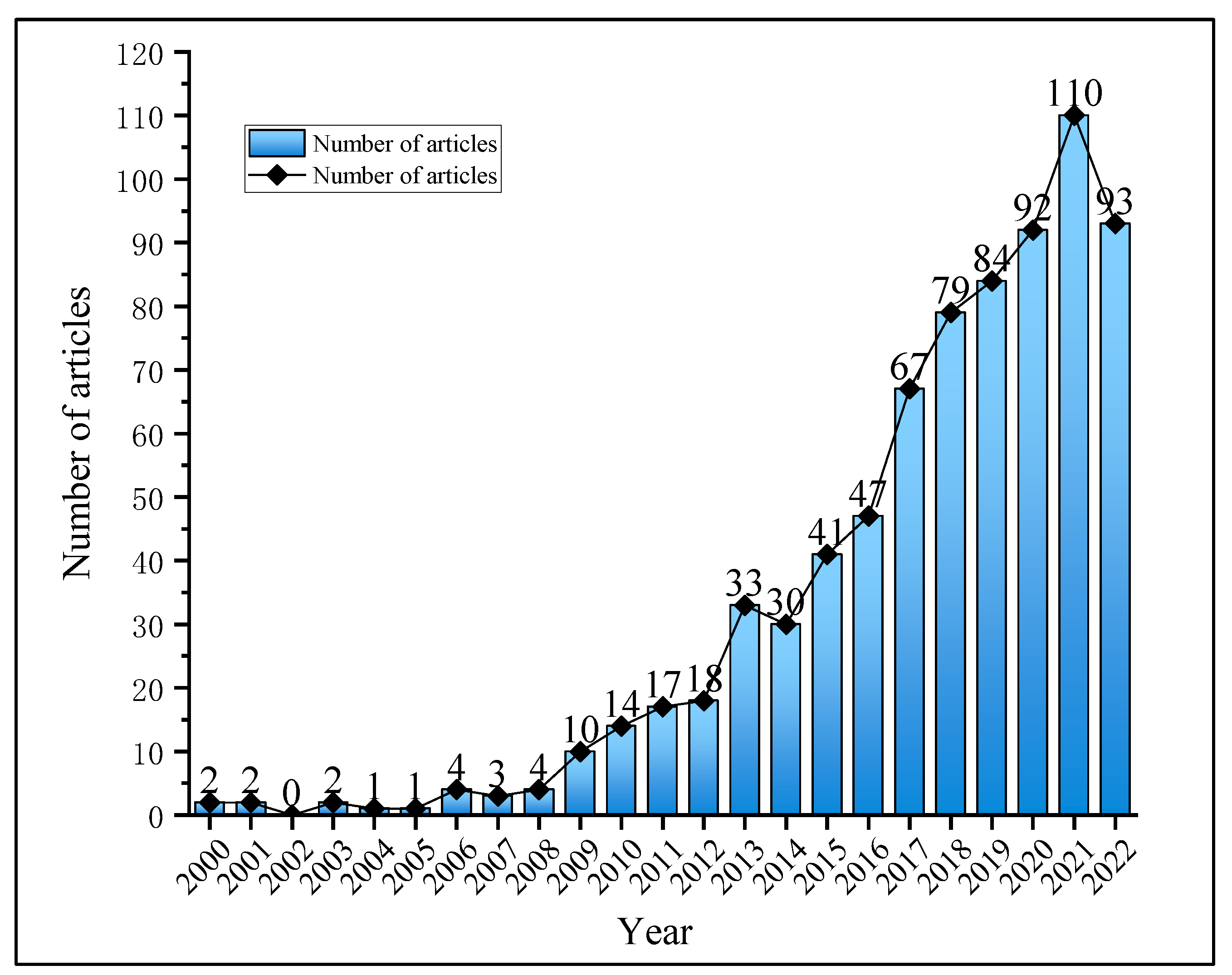
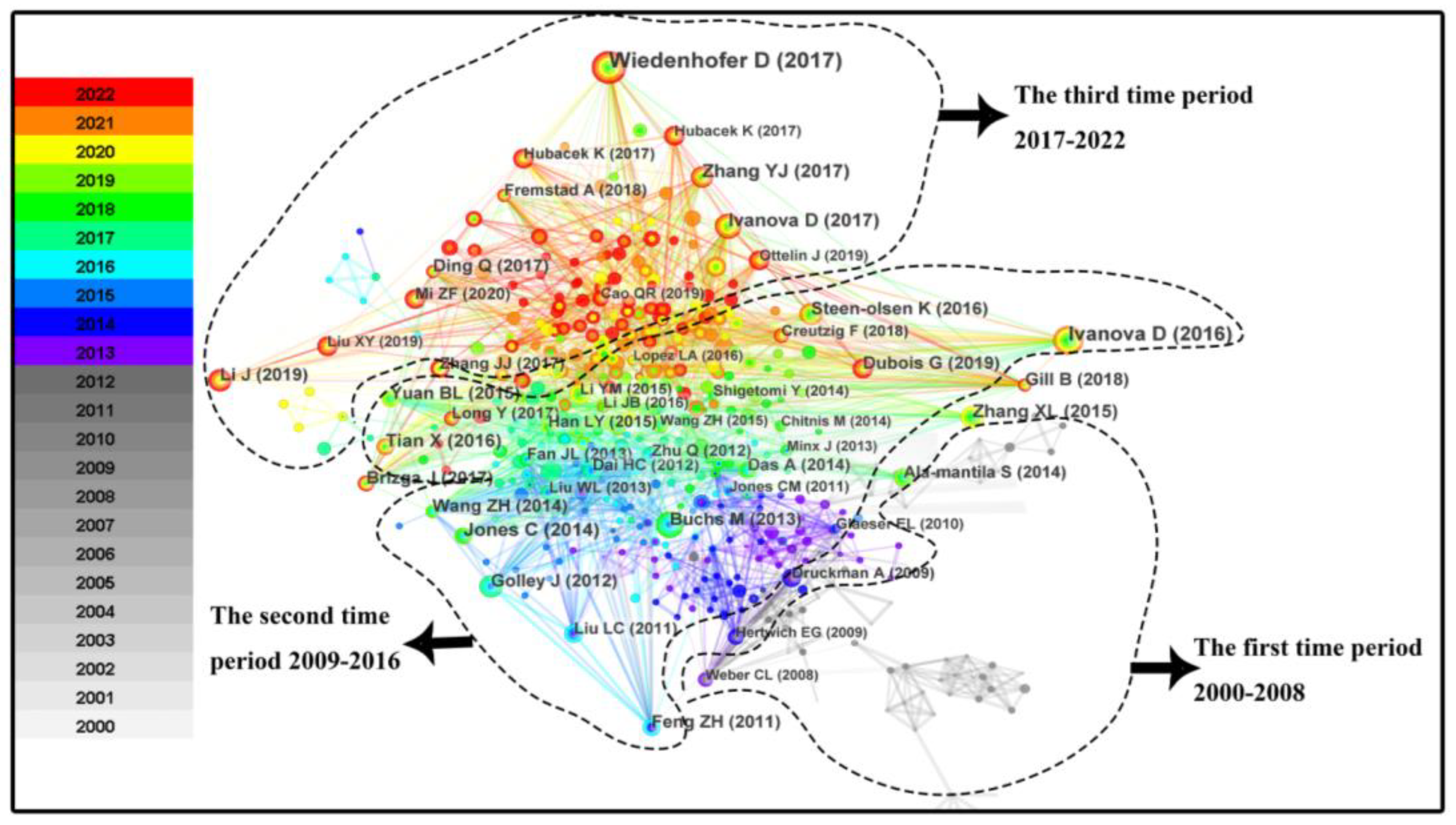
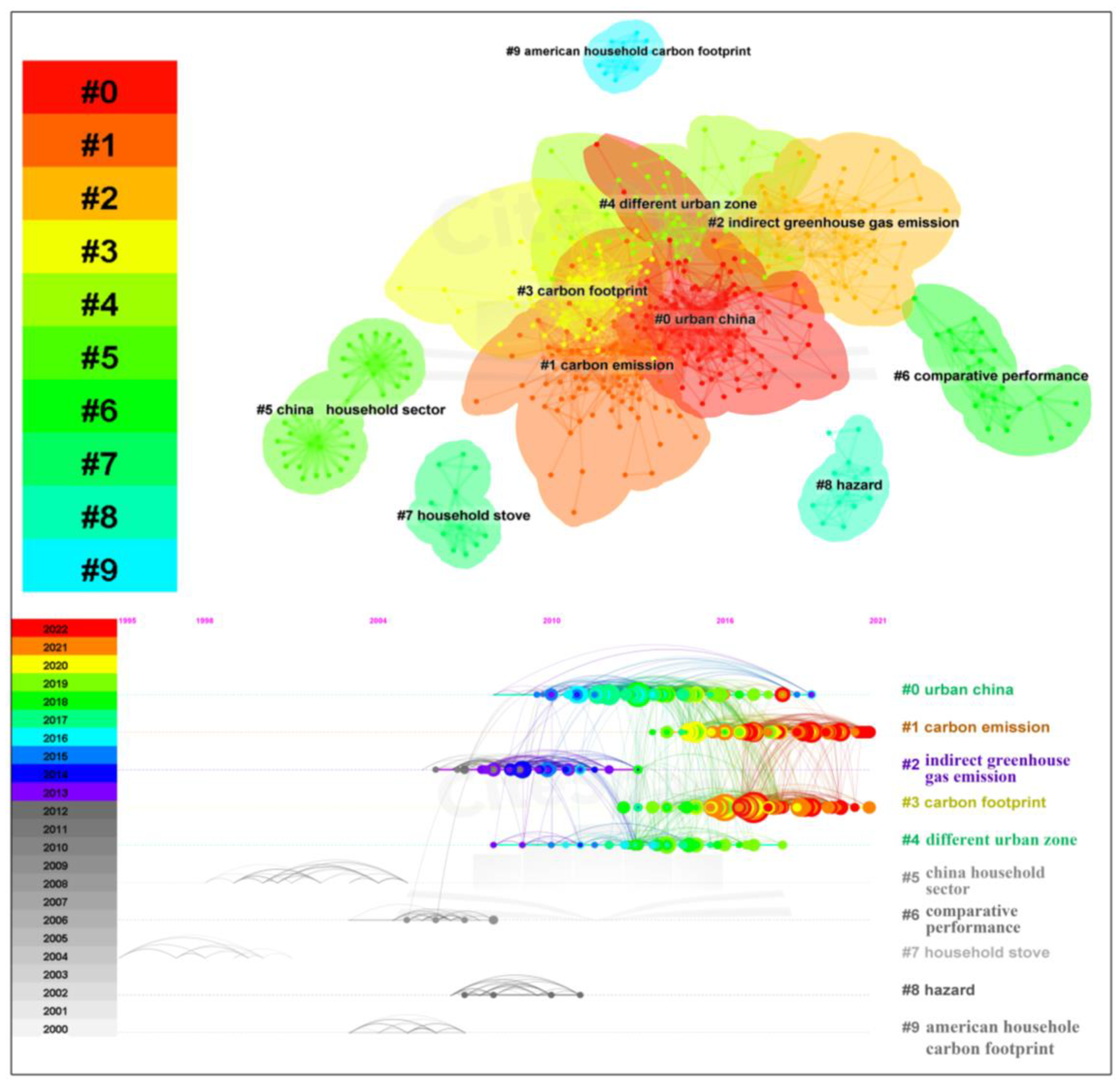
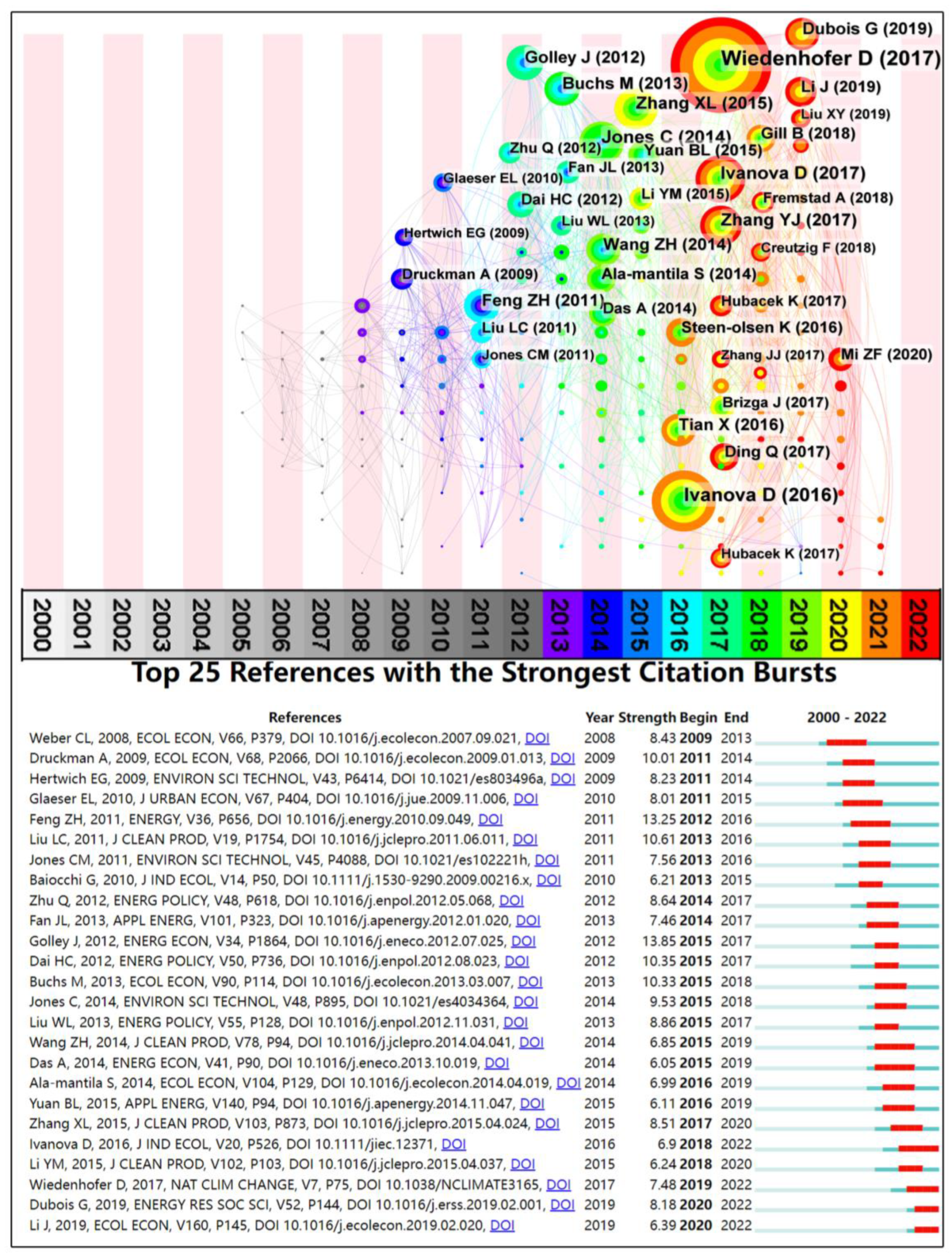

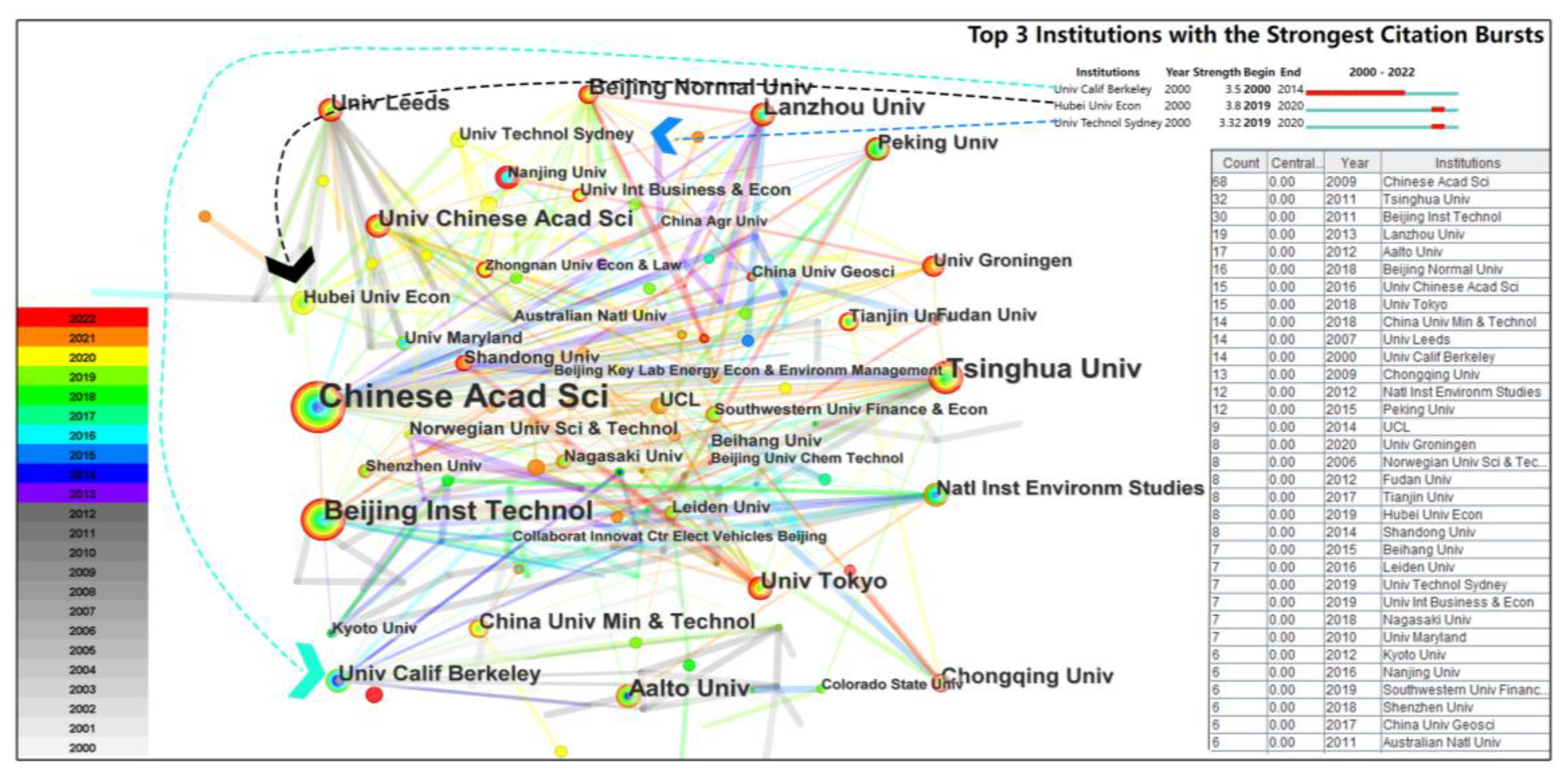
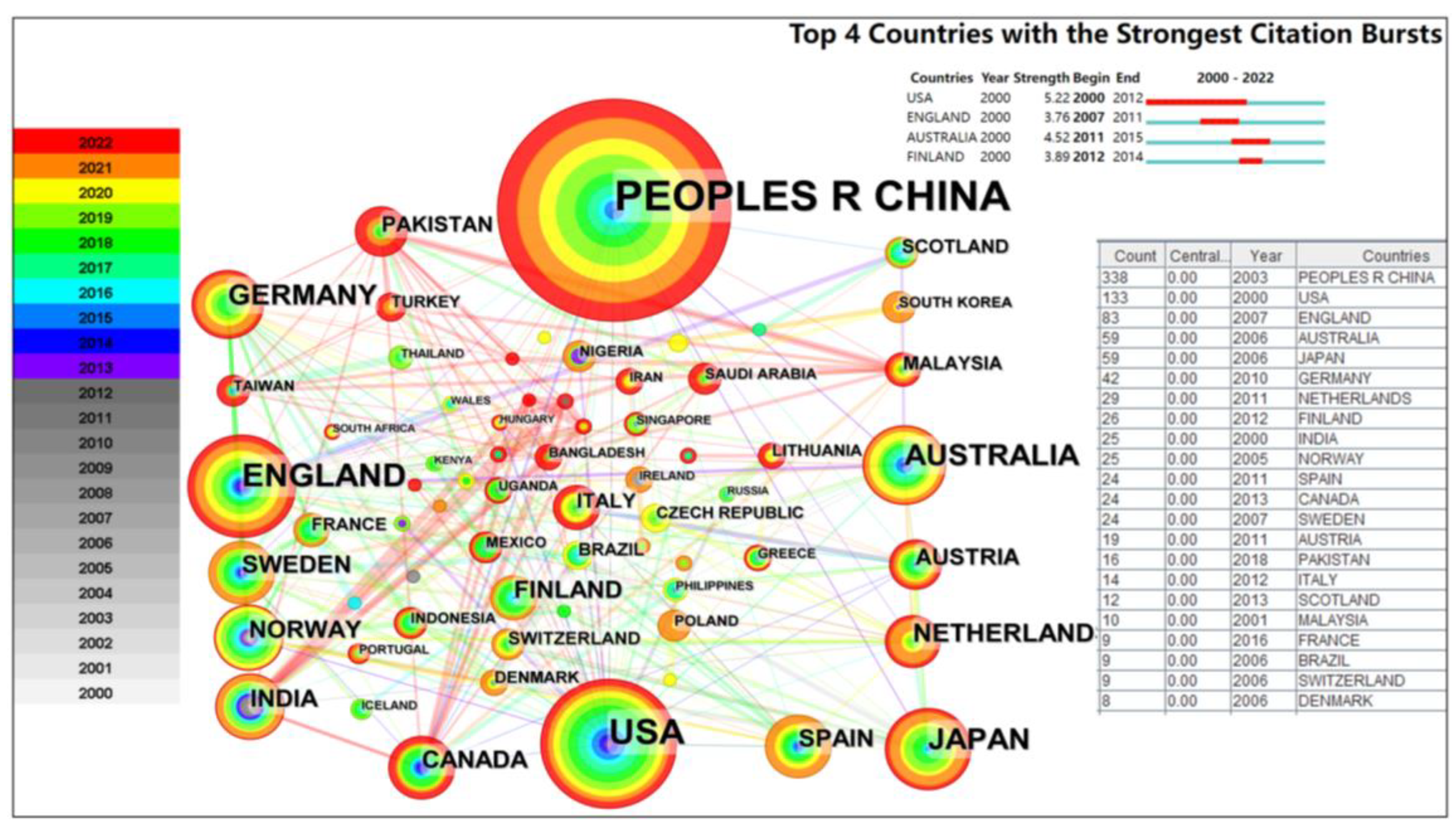

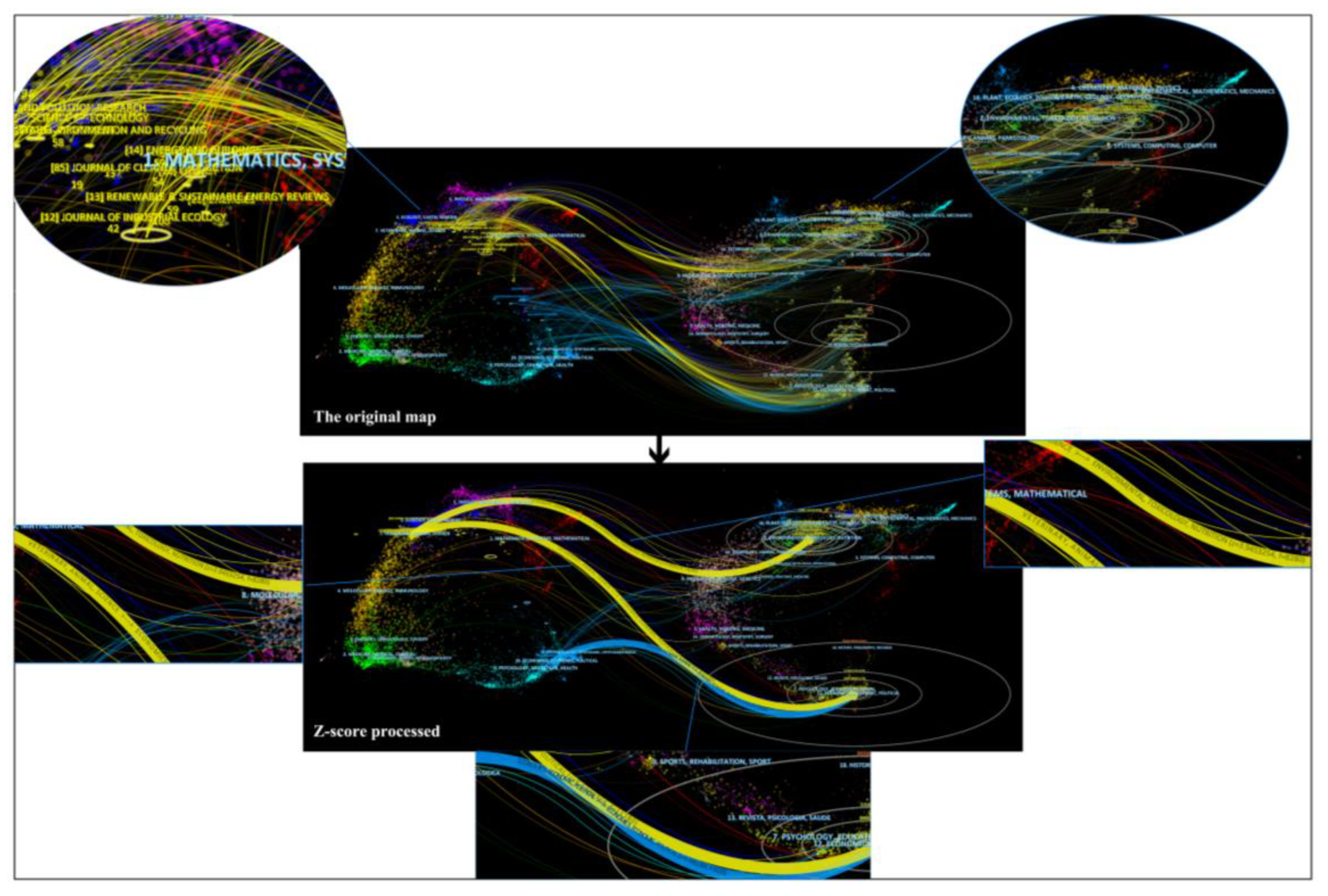
| Search Setup | Parameters and Results |
|---|---|
| Database | Web of Science Core Collection = Science Citation Index Expanded(SCI-EXPANDED)--1999-present + Social Sciences Citation Index(SSCI)--1999-present |
| Search Formula | Topic = household* and (“carbon footprint*” or ((CO2 or carbon dioxide or GHG or “greenhouse* gas*”)and (emit* or emission* or accounting*))) |
| Date Range | (2000–2022) |
| Search Time | 3 October 2022 |
| Document Types | Article, Review Article, Proceeding Paper |
| Records | 3042 |
| Step | Judgement Criteria | Example of Screened-Out Articles |
|---|---|---|
| Browse article titles, keywords, abstracts | 1. Whether the main research object is the household carbon footprint? | Hu et al. (2019) [52], da Silva et al. (2021) [53], Erdogan (2022) [54], etc. |
| 2. Does it describe the effectiveness of a technique, method, policy, model, etc.? | Padgett et al. (2008) [55], Bravo et al. (2013) [56], Akizu-Gardoki et al. (2021) [57], etc. | |
| 3. Is the household carbon footprint only used as a knowledge context? | Ward et al. (2011) [58], Rao et al. (2016) [59], Grabow et al. (2018) [60], etc. | |
| 4. Is it focused on the relationship between household and carbon footprint? | Fissore et al. (2011) [61], Li et al. (2009) [62], Ma et al. (2019) [63], etc. |
| Rank | Count | Year | Literature Cited |
|---|---|---|---|
| 1 | 77 | 2017 | Wiedenhofer D, 2017, NAT CLIM CHANGE, V7, P75, DOI 10.1038/NCLIMATE3165 [32] |
| 2 | 49 | 2016 | Ivanova D, 2016, J IND ECOL, V20, P526, DOI 10.1111/jiec.12371 [93] |
| 3 | 38 | 2017 | Ivanova D, 2017, ENVIRON RES LETT, V12, P0, DOI 10.1088/1748-9326/aa6da9 [94] |
| 4 | 35 | 2017 | Zhang YJ, 2017, J CLEAN PROD, V163, P69, DOI 10.1016/j.jclepro.2015.08.044 [91] |
| 5 | 34 | 2014 | Jones C, 2014, ENVIRON SCI TECHNOL, V48, P895, DOI 10.1021/es4034364 [98] |
| 6 | 33 | 2015 | Zhang XL, 2015, J CLEAN PROD, V103, P873, DOI 10.1016/j.jclepro.2015.04.024 [95] |
| 7 | 29 | 2016 | Tian X, 2016, J CLEAN PROD, V114, P401, DOI 10.1016/j.jclepro.2015.05.097 [72] |
| 8 | 28 | 2015 | Yuan BL, 2015, APPL ENERG, V140, P94, DOI 10.1016/j.apenergy.2014.11.047 [96] |
| 9 | 28 | 2017 | Brizga J, 2017, APPL ENERG, V189, P780, DOI 10.1016/j.apenergy.2016.01.102 [99] |
| 10 | 28 | 2012 | Golley J, 2012, ENERG ECON, V34, P1864, DOI 10.1016/j.eneco.2012.07.025 [97] |
| Cluster ID | Size | Silhouette | Mean (Year) | Top Terms (LLR) | Parts in Time Stage |
|---|---|---|---|---|---|
| #0 | 103 | 0.929 | 2013 | Urban China | 2 |
| #1 | 94 | 0.829 | 2018 | Carbon emission | 3 |
| #2 | 80 | 0.956 | 2009 | Indirect greenhouse gas emission | 2 |
| #3 | 77 | 0.918 | 2017 | Carbon footprint | 3 |
| #4 | 57 | 0.869 | 2013 | Different urban zone | 2 |
| #5 | 37 | 1 | 2001 | China household sector | 1 |
| #6 | 26 | 1 | 2006 | Comparative performance | 1 |
| #7 | 15 | 1 | 2000 | Household stove | 1 |
| #8 | 15 | 1 | 2008 | Hazard | 1 |
| #9 | 13 | 1 | 2005 | American household carbon footprint | 1 |
| Paths | Journal Overlay Maps (Topics: Citing Pattern->Cited Pattern) | Z-Score | Frequency (f) |
|---|---|---|---|
| 1 | VETERINARY, ANIMAL, SCIENCE->ENVIRONMENTAL, TOXICOLOGY, NUTRITION | 3.9453254 | 4830 |
| 2 | VETERINARY, ANIMAL, SCIENCE->ECONOMICS, ECONOMIC, POLTICAL | 5.5301766 | 6580 |
| 3 | ECONOMICS, ECONOMIC, POLTICAL->ECONOMICS, ECONOMIC, POLTICAL | 4.4461384 | 5383 |
Disclaimer/Publisher’s Note: The statements, opinions and data contained in all publications are solely those of the individual author(s) and contributor(s) and not of MDPI and/or the editor(s). MDPI and/or the editor(s) disclaim responsibility for any injury to people or property resulting from any ideas, methods, instructions or products referred to in the content. |
© 2023 by the authors. Licensee MDPI, Basel, Switzerland. This article is an open access article distributed under the terms and conditions of the Creative Commons Attribution (CC BY) license (https://creativecommons.org/licenses/by/4.0/).
Share and Cite
Shen, F.; Simayi, Z.; Yang, S.; Mamitimin, Y.; Zhang, X.; Zhang, Y. A Bibliometric Review of Household Carbon Footprint during 2000–2022. Sustainability 2023, 15, 6138. https://doi.org/10.3390/su15076138
Shen F, Simayi Z, Yang S, Mamitimin Y, Zhang X, Zhang Y. A Bibliometric Review of Household Carbon Footprint during 2000–2022. Sustainability. 2023; 15(7):6138. https://doi.org/10.3390/su15076138
Chicago/Turabian StyleShen, Fang, Zibibula Simayi, Shengtian Yang, Yusuyunjiang Mamitimin, Xiaofen Zhang, and Yunyi Zhang. 2023. "A Bibliometric Review of Household Carbon Footprint during 2000–2022" Sustainability 15, no. 7: 6138. https://doi.org/10.3390/su15076138
APA StyleShen, F., Simayi, Z., Yang, S., Mamitimin, Y., Zhang, X., & Zhang, Y. (2023). A Bibliometric Review of Household Carbon Footprint during 2000–2022. Sustainability, 15(7), 6138. https://doi.org/10.3390/su15076138





